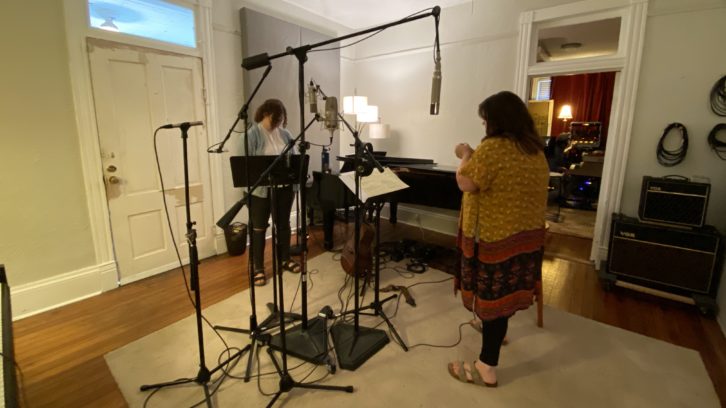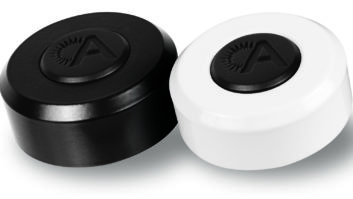
The songs compiled on Woody Guthrie’s original Dust Bowl Ballads collection (1940) decry the tragedy of a “climate crisis” that predates the term. Guthrie’s songs are populated by “refugees” of the North American prairies, fleeing a fruitless land spoiled by drought, wind and agricultural devastation.
“Thinking about Woody Guthrie and his musical legacy, I went back to the Dust Bowl Ballads and felt its resonance and its relevance to what’s happening in the world now,” says Randall Poster, who produced Home In This World, a new track-by-track remake of Guthrie’s classic. “I thought it would be compelling to have a collection of some of my favorite artists and my favorite voices take it on, and see if we could somewhat joyfully elevate the conversation and draw people’s attention to the fact that, through our efforts, we can actually turn back some of the ill effects of global warming.”
Poster—a renowned music supervisor for film as well as a Grammy-winning music producer, whose credits range from Wes Anderson’s films to Netflix series Tiger King and The Queen’s Gambit—partnered with the Kiss the Ground foundation, a group that teaches ways to care for the planet through regenerative agriculture. The superb group of artists that Poster tapped to sing Guthrie’s iconic songs includes Americana stars such as Shovels & Rope singing “Dust Bowl Blues,” Lost Dog Street Band doing “I Ain’t Got a Home in This World Anymore,” the Secret Sisters harmonizing on “This Dust Cain’t Kill Me” and Lee Ann Womack singing “Dusty Old Dust.” Other highlights include Waxahatchee with an intimate take on “Talking Dust Bowl Blues,” blues singer Swamp Dogg on “Dust Bowl Refugee,” and former Queens of the Stone Age frontman Mark Lanegan with “Dust Pneumonia Blues.”
Birth of the Bootlegs—Part 1: The First Bootleg Record
Swamp Dogg and Lanegan were both coproduced by Poster’s friend George Drakoulias and Brendan O’Brien, who also played most of the instrumental parts in his personal studio. “Brendan’s room is perfect for mixing, songwriting and overdubbing,” says Kyle Stevens, who engineered all of O’Brien’s parts and mixed the two songs. “We’ve got an SSL Origin console, as well as our Pro Tools rig running on a Mac with [Apogee] Symphony. There is a control room and a vocal booth.
“But this all happened last summer,” Stevens continues. “It was early in the pandemic, when everything was shutting down and there were no vaccines yet. We needed to be really cautious, and we definitely didn’t feel comfortable having a group of people come in to that small space; that’s why most of that stuff was just Brendan and I working in there with masks on.”
Drakoulias joined the sessions via FaceTime as Stevens captured O’Brien’s parts to Pro Tools, using their go-to recording chain for backing vocals and guitars: a Neumann U67 mic into a Tube-Tech MP1a mic preamp to a Tube- Tech PE1b EQ and then some Tube-Tech CL1a compression.
“We’d get a basic arrangement idea and send each song to Mark and Swamp Dogg. Then each of them recorded their vocal wherever they were and sent it to us, and we would build the song out around that. Some of the drum kit sounds we used were kits from Logic, but we’d stack them or manipulate them to make them sound more unique. Other percussion lines are from a collection of tracks that we’ve recorded over the years.”
In the Studio with The Darkness
For example, there’s a crunchy stomping sound on Lanegan’s version of “Dust Pneumonia Blues” that elevates the whole track. “Brendan has a big road case—a Pelican percussion case that is full of cymbal stands, tambourines, shakers, you name it,” Stevens explains. “That sound is literally him picking up the box and dropping it on the floor. We had an [AKG] C414 on the floor, through a [Universal Audio] 1176 and a Neve [mic pre], which is our setup whenever we’re recording some kind of percussion.”
Two other songs on the album—John Paul White’s cover of “Pretty Boy Floyd” and the Secret Sisters’ “Dust Cain’t Kill Me”—were recorded and mixed in Sundrop Sound studio (Florence, Ala.) by studio co-owner/engineer Ben Tanner, also known as the keyboardist for Alabama Shakes.
“Our studio is in a house that was built in the early 1900s,” Tanner says. “It has high ceilings and big rooms, and we’ve left it pretty much like a house. What was the living room is now the live room, where we often set up drums. To the right of that is the dining room, which is separated by a partition. The master bedroom is my control room, and what was the master bathroom is a tape room. Different rooms can be opened or closed to give us separation, but it’s also possible to get everybody together in the live room.”
For “Pretty Boy Floyd,” the players were White, singing and playing acoustic guitar in the live room; drummer Todd Roper, who also plays with Cake; and bass player Shonna Tucker. Tanner captured everything to Pro Tools via White’s favorite vocal mic—an SM7—and a Microtech Gefell UM71 on White’s guitar.
“I’ve got two API clones from Seventh Circle Audio that we had a tech tweak to make them closer to actual API 512s,” Tanner says. “I put his guitar and vocal through those, as well as a Daking FET compressor. On John live, I always use very light compression—probably five- or ten-to-one with slow attack and release.” Roper and Tucker also appear on the Secret Sisters’ song, which was added to sessions already in progress for a four-song EP they were making with Tanner.
“Todd and Shonna are both local,” says Tanner. “The only out-of-towner on the Sisters’ session was Cheyenne Medders. He primarily plays guitar. He is just a great guy to have around because he can jump on anything as needed and switch around between acoustic and electric.
“With everything we worked on, whether it was for the EP or this tribute record, we started with Laura and Lydia [Rogers] singing together with the band, and for the most part, we used live vocals. Laura was on an Upton 251 clone and Lydia was on a [Neumann] U67. We did several full-band passes, so we’d have plenty to pull from. That song is 90 percent live vocals with just a couple of little punches.
“I’ve known them for quite a while because we’re from the same area,” Tanner continues. “This was my first time working on a proper Secret Sisters project, but I’d worked with them as background singers. The first time I heard them together on a microphone, it was mind-blowing. The sibling harmony thing is definitely magical.”
Tanner also added his own kind of magic to both of the tracks he worked on: His Wurlitzer organ parts elevate both songs in different ways. “That was a Wurly 145,” he says. “It has a tube gain stage in it, and the direct out sounds way better than most keyboard direct outs, so I took that and hit it with light compression on the way in.”
As on Stevens’ and O’Brien’s sessions, Covid was a factor for Tanner and the musicians in Sundrop, but through a combination of testing, caution and communication, they managed to record live without incident.
“That was the unique challenge that we all had,” Poster reflects. “Some people had to record at home. With the ebb and flow of the virus, a couple of artists found ways to use a bigger schematic while practicing safety protocols. It was a sensitive and challenging time, but one thing we had in our favor is that, for the most part, the tracks are pretty stripped-down. They all have a simple human touch to them, and that elemental quality is part of the strength of Woody Guthrie’s message.”







